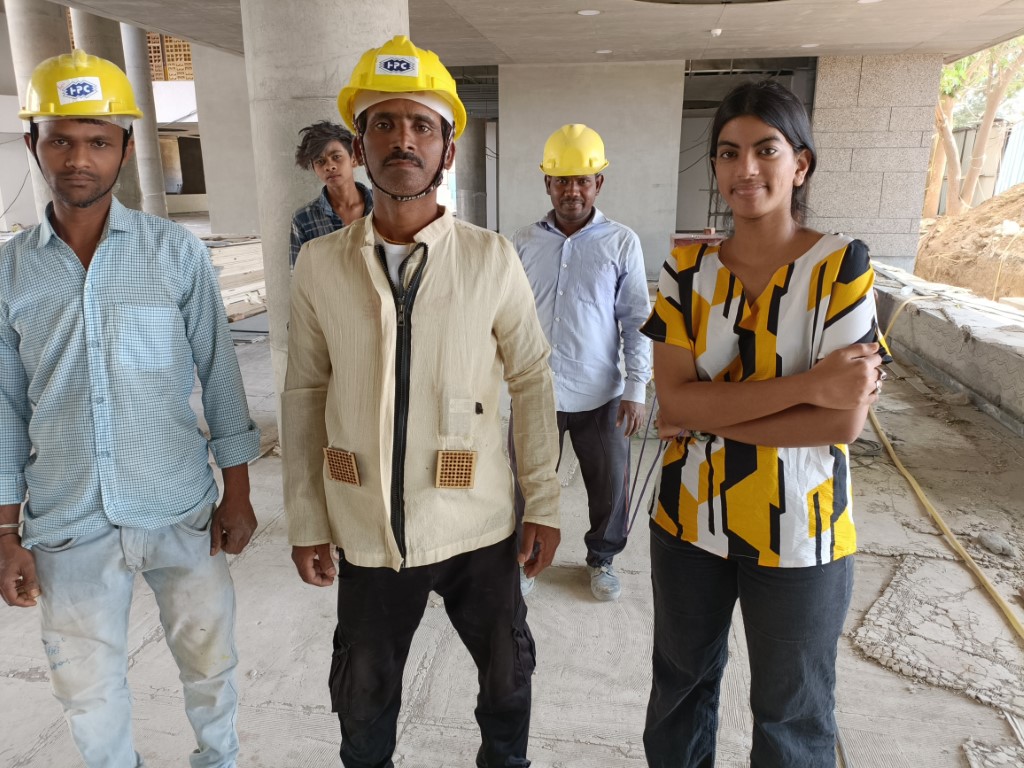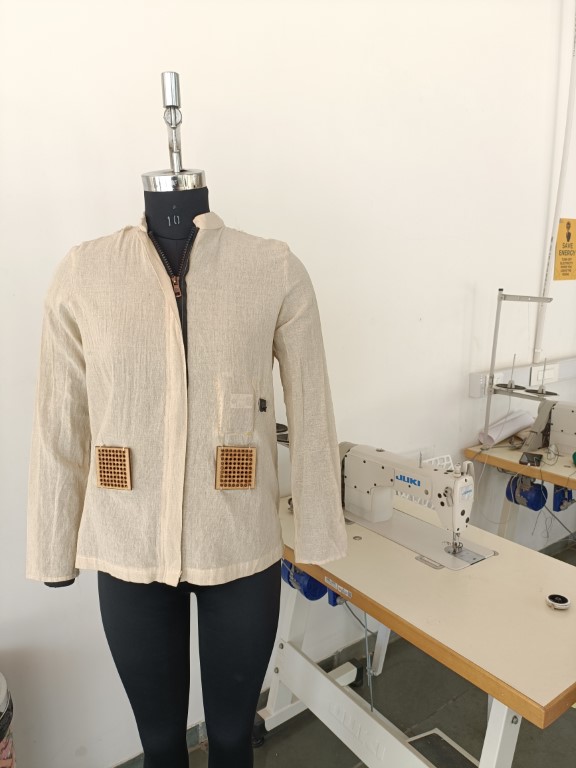Published on: Monday, 01 July 2024 ● 6 Min Read

Meet Sanyukta, a forward-thinking student at Anant National University, whose innovative spirit has led to the creation of Vastra-Cool – a pioneering work jacket designed from repurposed e-waste to provide relief to construction workers battling scorching heat. Discover her journey of blending fashion design with product innovation and sustainability.
What inspired you to create Vastra-Cool, and how did you come up with the idea of using repurposed e-waste for its construction? At Anant, my major is Fashion Design, with Product Design as my minor. As a product design student, I wanted to design something that could contribute to the environmental cause and have a social impact. During one of many brainstorming sessions, the idea of Vastra-Cool took shape. The summers are getting hotter every year, making it challenging for people working outdoors. So, I designed this work jacket for construction workers as their work exposes them to severe heat. This jacket is an attempt to offer some relief.
Can you walk us through the design process of Vastra-Cool? How did you ensure that functionality and sustainability were prioritised in its development?

This workwear jacket, crafted from repurposed e-waste, prioritises the environment while enhancing comfort and functionality. Made with muslin, an ideal material for summer, it features four fans—two in the front and two at the back—to ensure optimal ventilation during strenuous working hours.
I sourced the cooling motor fans from the Sunday scrap market in Ahmedabad, tested all the components and marked the dimensions. I then worked on the cloth in Anant’s fully-equipped Fashion Lab. The final assembly, including fitting the fans and other battery-driven components, was completed in Makerspace, Anant’s state-of-the-art digital lab for prototyping and product development.
Could you elaborate on the technical aspects of Vastra-Cool? What materials and technologies were utilised to achieve its cooling properties? In Vastra-cool, we have used a regular 12V cooling fan with 1000 plus rpm for good airflow. The fans have been arranged in a way that they circulate the air properly. The safety aspects have also been taken into account as we have attached the outer housing to the motor, which is made using laser cutting so that the blade and the skin don’t come in contact.
How do you envision Vastra-Cool impacting the lives of construction workers and other professionals working in extreme heat conditions? Vastra-Cool is currently in its alpha prototype stage, and we have tested it on construction workers who endure sweltering working conditions. Typically, they sweat throughout the afternoon, leading to irritation and decreased work efficiency. The results of our testing have been remarkable, as Vastra-Cool provided significant relief. The jacket circulates air inside effectively, with motors strategically placed to draw in air from the surroundings through the suction part and expel it into the jacket through the exhaust, ensuring continuous airflow.

What were some of the challenges you faced during the development of Vastra-Cool, and how did you overcome them? When I started working on the idea of Vastra-Cool, putting the electronic parts together was a challenge as I was not adept at it. However, I learnt the basics of electronics in my Product Design class, my minor subject. The learnings helped me a lot in assembling the electronic parts of the jacket, and I was able to design the first prototype.
As a Sustainable Fashion and Textile Design student with a minor in Product Design, how do you see your background influencing your approach to innovation and sustainability in fashion and product development? Product Design as a minor gives solid support to my major – Sustainable Fashion and Textile Design. Since the government is promoting such initiatives and providing multiple funding opportunities to start-ups, I feel I can go a long distance in my journey to design sustainable, useful and impactful products.
How did the mentorship provided during the development of Vastra-Cool contribute to its success, and what insights or guidance did you find particularly valuable during the process? During the course, the practical exposure and learning through hands-on modules greatly impacted my skills. The course has been designed to help students understand the basics of design, think critically, identify problems and devise practical solutions for them. Anant has the proper infrastructure to promote practical learning. Their Fashion Labs and Makerspace have the right equipment to ensure students can design and develop their products.
Apart from that, the mentorship offered helps us in all ways possible. I got complete support from my mentor, Prof Parth Shah, who helped me with everything from sketching to bringing Vastra-Cool to life.
What are your plans for further iterations or developments of Vastra-Cool? Are there any other applications or industries where you see this technology being utilised? Yes, we have planned some new iterations. These improved prototypes will be developed during the second design stage, which we call the Beta Level prototype. This prototype will have better batteries and motors for enhanced performance.
Sustainability is a key aspect of your project. Could you share some insights into the environmental impact of Vastra-Cool compared to traditional workwear materials and how you plan to address any potential challenges in scaling up production sustainably? Vastra-Cool is made from muslin, which is easily biodegradable and skin-friendly. The fabric is more affordable, and there is no more exterior process required to make the product aesthetic. So, a lot of material and energy is saved.
Following these questions, Prof Parth Shah, Manager at Makerspace and Assistant Professor at Anant National University, shares his insights:

How does Anant National University’s Makerspace support and encourage students like Sanyukta to pursue innovative projects like Vastra-Cool? Makerspace is a place where interdisciplinary students work with different materials like wood, metal, clay, plaster of Paris, MDF, fabrics and cardboard. Students at Makerspace blend design, art and technology to fulfil their design dreams and bring them to fruition. As the manager at Makerspace and an Assistant professor at the School of Design, I encourage students to work and learn hands-on techniques to build prototypes.
What role does the university play in fostering a culture of innovation and sustainability among its students, particularly in facilitating interdisciplinary collaboration between fields such as Sustainable Fashion and Product Design? The core of our pedagogy is sustainable design multiplied by a host of knowledge disciplines and technology to make problem-solving impactful. Our multidisciplinary undergraduate, postgraduate and doctoral programmes in design, architecture, climate action and visual arts harness the knowledge from various disciplines and traditional practices to integrate it with cutting-edge technology to address diverse challenges.
In majors like Sustainable Fashion and Textile Design, students get to learn from industry experts to understand how the real world functions. We also arrange industry visits where students learn practical skills and implement them in their studio classes. Anant also provides students with the opportunity to enrol and interact with different start-ups to enhance their entrepreneurial skills and learn from mentors.
No comments posted
© 2019 KIVAA Group | All right reserved. www.theindustrial.in
Leave a reply: